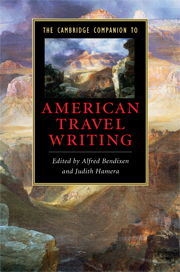Book contents
- Frontmatter
- Introduction: new worlds and old lands - the travel book and the construction of American identity
- Part I Confronting the American landscape
- 1 Beginnings: the origins of American travel writing in the pre-revolutionary period
- 2 “Property in the horizon”: landscape and American travel writing
- 3 New York to Niagara by way of the Hudson and the Erie
- 4 The Mississippi River as site and symbol
- 5 The Southwest and travel writing
- Part II Americans abroad
- Part III Social scenes and American sites
- Chronology
- Further Reading
- Index
2 - “Property in the horizon”: landscape and American travel writing
from Part I - Confronting the American landscape
Published online by Cambridge University Press: 28 March 2009
- Frontmatter
- Introduction: new worlds and old lands - the travel book and the construction of American identity
- Part I Confronting the American landscape
- 1 Beginnings: the origins of American travel writing in the pre-revolutionary period
- 2 “Property in the horizon”: landscape and American travel writing
- 3 New York to Niagara by way of the Hudson and the Erie
- 4 The Mississippi River as site and symbol
- 5 The Southwest and travel writing
- Part II Americans abroad
- Part III Social scenes and American sites
- Chronology
- Further Reading
- Index
Summary
Landscape is “a construct of the mind and of feeling,” according to Yi-Fu Tuan, a human invention that “can take place only in the mind's eye.” “[D]escriptions of the environment are never merely empirical,” writes Robert Lawson-Peebles. “They are strategies which encode the interests and concerns of the writer as well as the physical nature of the terrain, the climate, and so on.” “Miller owns this field, Locke that, and Manning the woodland beyond,” writes Emerson, “[b]ut none of them owns the landscape. There is property in the horizon which no man has but he whose eye can integrate all the parts, that is, the poet.” All three of these writers consider the apprehension of a landscape to be a creative act involving the active perception, organization, and interpretation of a set of empirical givens. Judith Adler says much the same about travel which, when it is “undertaken and executed with a primary concern for the meanings discovered, created, and communicated as persons move through geographical space,” has the ability to “bestow[] meaning on the self and the social, natural, or metaphysical realities through which it moves.” Moving through the world, observing one's surroundings, giving shape and meaning to what one sees, these activities combine the satisfaction of study and the exhilaration of creative art with a sense of ownership, of “property in the horizon.”
- Type
- Chapter
- Information
- The Cambridge Companion to American Travel Writing , pp. 26 - 45Publisher: Cambridge University PressPrint publication year: 2009

